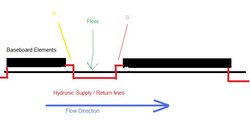SO I know that I need an air separator in my system, but my question is where and how many. I will be using Slant Fin Multi/Pak baseboards, 2 - 3 zones depending on final planning. Reading the installation manual, if I understood it correctly, it says to install an air separator at each riser. If I'm not mistaken, that would be each time the supply line comes up from under the floor, I need a separator? So where exactly should i put them? I made a goofy little sketch to help illustrate my question.
Do i put the separator at point A or point B? Or somewhere entirely different. Any guidance on this topic would be MUCH appreciated.
-Eric
PS- I will be installing a pensotti radiator in one of the rooms. Does it need a separator as well?
Do i put the separator at point A or point B? Or somewhere entirely different. Any guidance on this topic would be MUCH appreciated.
-Eric
PS- I will be installing a pensotti radiator in one of the rooms. Does it need a separator as well?



